Consider a world where you can access untapped data resources that allow your healthcare organization to improve performance, deliver better patient outcomes, and cut costs. However, this data contains sensitive, protected health information (PHI) subject to strict regulations. With robust healthcare data compliance processes, your organization could avoid severe penalties for mishandling this data.
This scenario is all too real for healthcare organizations today. As you navigate healthcare data management, prioritizing compliance will help you avoid costly fines and penalties, ensuring your organization can operate smoothly and achieve its goals. This guide will provide valuable insights to help you improve your healthcare data compliance processes and avoid potential pitfalls.
Azulity’s healthcare master data management services can help your organization achieve its data management goals by streamlining compliance processes so you can keep your focus on operations and improving patient care.
What Is Healthcare Data Compliance?

Healthcare data compliance refers to the processes and technology healthcare organizations use to protect sensitive patient data from breaches and cyberattacks. Compliance ensures organizations follow regulations to protect patient data and maintain patient trust. In healthcare, where breaches impact millions of records, a robust compliance plan is critical to patient safety and organizational success.
Why Healthcare Data Compliance Is Important
Healthcare data compliance is essential for a range of reasons. First, it helps protect patient data from cybercriminals, especially when healthcare organizations are particularly vulnerable to attacks. Next, compliance helps organizations avoid fines and penalties associated with data privacy regulations. Lastly, maintaining a high level of compliance can help healthcare organizations recover faster from a breach and protect their reputation, as patients are more likely to trust compliant organizations.
Related Reading
- Data Quality Management in Healthcare
- How to Secure Patient Data
- Master Data Management Solutions
- Patient Data Management System
Importance of Healthcare Data Compliance


Keeping Patient Data Safe with Healthcare Data Compliance
Healthcare data compliance safeguards sensitive patient information from breaches and unauthorized access. Regulations like HIPAA (Health Insurance Portability and Accountability Act) in the U.S. set standards for protecting patient information and giving patients rights over their data. Compliance helps prevent data breaches and protects patient privacy. For instance, in 2015, Anthem, one of the largest health insurers in the U.S., experienced a data breach that exposed nearly 80 million records. The company faced a $16 million settlement, which could have been avoided with stricter data security measures. The breach highlighted the importance of adhering to compliance requirements to prevent similar financial and reputational damage.
Building Trust with Patients Through Healthcare Data Compliance
Patients trust healthcare providers with their sensitive information, and compliance with data protection regulations helps maintain this trust. For example, the NHS in the UK has strict protocols under the General Data Protection Regulation (GDPR) to protect patient data. When the NHS introduced contact tracing during the COVID-19 pandemic, compliance with GDPR was essential to reassure the public that their data would be used responsibly. This was critical in getting people to use the service and protect public health.
Improving Data Accuracy and Interoperability
Health data compliance promotes data handling, sharing, and accuracy across healthcare systems. In the U.S., the HITECH Act (Health Information Technology for Economic and Clinical Health) was implemented to promote the secure, interoperable sharing of electronic health records (EHRs). Organizations like Kaiser Permanente have implemented HITECH-compliant systems, allowing for smooth information exchange and reducing medical errors, which can result from inaccurate or inaccessible data.
Avoiding Legal Trouble with Healthcare Data Compliance
Healthcare providers can face significant fines for non-compliance. For example, in 2020, the Florida-based company CHSPSC LLC was fined $2.3 million after failing to comply with HIPAA’s data security regulations, leading to a data breach impacting over 6 million individuals. This case illustrates how non-compliance affects patients and poses costly legal and financial risks to healthcare providers.
Improving Patient Outcomes with Ethical Healthcare Data Compliance
Compliance ensures that patient data is used ethically and to improve patient care. For instance, researchers at Cleveland Clinic conduct studies using de-identified patient data to improve treatments without compromising patient privacy. By complying with HIPAA and other regulations, they ensure that data is used responsibly, supporting better patient outcomes and advancing medical research.
Facilitating Telemedicine Safely Through Compliance
The rise of telemedicine, especially during the COVID-19 pandemic, highlighted the importance of secure, compliant healthcare data handling. Companies like Teladoc Health strictly adhere to HIPAA guidelines for telemedicine, ensuring that patient data shared during virtual appointments is encrypted and protected from unauthorized access. This compliance was crucial in building confidence in telehealth services, which became essential for remote care during lockdowns.
Enabling Global Collaboration in Research
Compliance also plays a role in international healthcare data sharing, which is essential for global health research. During the COVID-19 pandemic, countries worldwide collaborated on vaccine research, and adherence to data compliance regulations like the GDPR was crucial for the ethical exchange of health data across borders. This collaboration helped accelerate vaccine development while protecting patient privacy globally.
Azulity’s Advanced Healthcare Master Data Management Solutions
Azulity specializes in healthcare master data management, bringing proven expertise in implementing healthcare data solutions and credentialing across the US. Our comprehensive platform ensures consistent patient, provider, location, and claims data synchronization across all systems and departments. Key features include healthcare MDM, provider MDM, reference data management, credentialing, and provider enrollment. We serve healthcare technology leaders – from CIOs and CDOs to VPs of data platforms and credentialing – helping them eliminate the costly problems of fragmented data systems. Book a call to learn more about our healthcare master data management services today!
9 Best Tools For Healthcare Data Compliance
1. Azulity: A Leader in Healthcare Master Data Management
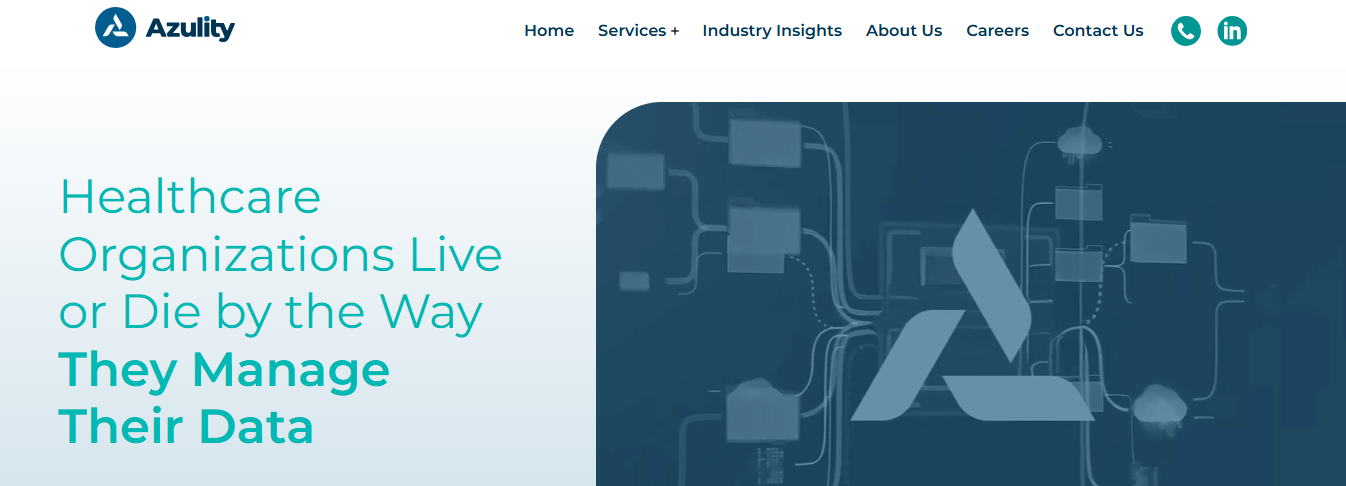

Azulity focuses on master data management in the healthcare sector. Their platform synchronizes patient, provider, location, and claims data across all departments and systems. Azulity’s solutions reduce compliance risks and costly errors by eliminating fragmented data.
Azulity’s key features include
- Healthcare MDM
- Provider MDM
- Reference data management
- Credentialing
- Provider enrollment
Compliance Focus
Azulity’s solutions help organizations achieve compliance by reducing the risks associated with data fragmentation.
2. Healthicity: Simplifying Compliance Management


Healthicity offers an all-in-one compliance solution that helps healthcare organizations manage their compliance programs efficiently. This digital solution simplifies compliance processes through automation and digitization, providing constant monitoring and detailed reporting to ensure compliance.
Key features of Healthicity include
- Dashboard reporting
- Audit management
- Risk assessment and incident management
Compliance Focus
Healthicity helps organizations enhance compliance with regulations through improved monitoring and reporting of compliance programs.
3. CompliancyGroup: HIPAA Compliance Made Easy
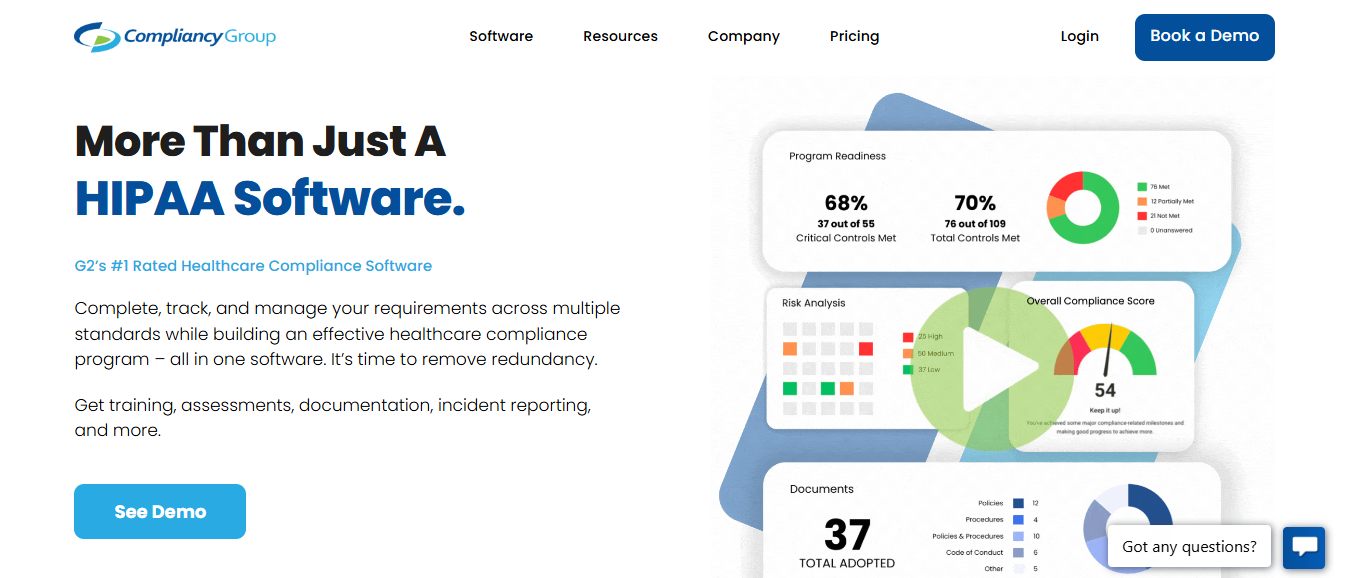

CompliancyGroup provides a cloud-based solution for HIPAA compliance and risk management. Their software streamlines achieving and maintaining compliance so organizations can focus on their patients, not regulations.
Key features of CompliancyGroup include
- HIPAA compliance checklist and assessment tools
- Business associate management
- Incident management
- Breach notification
- Customizable policy templates
Compliance Focus
CompliancyGroup’s software helps organizations manage HIPAA compliance throughout the entire compliance lifecycle, from initial assessment to ongoing maintenance.
4. Verge Health: Transforming Compliance Management
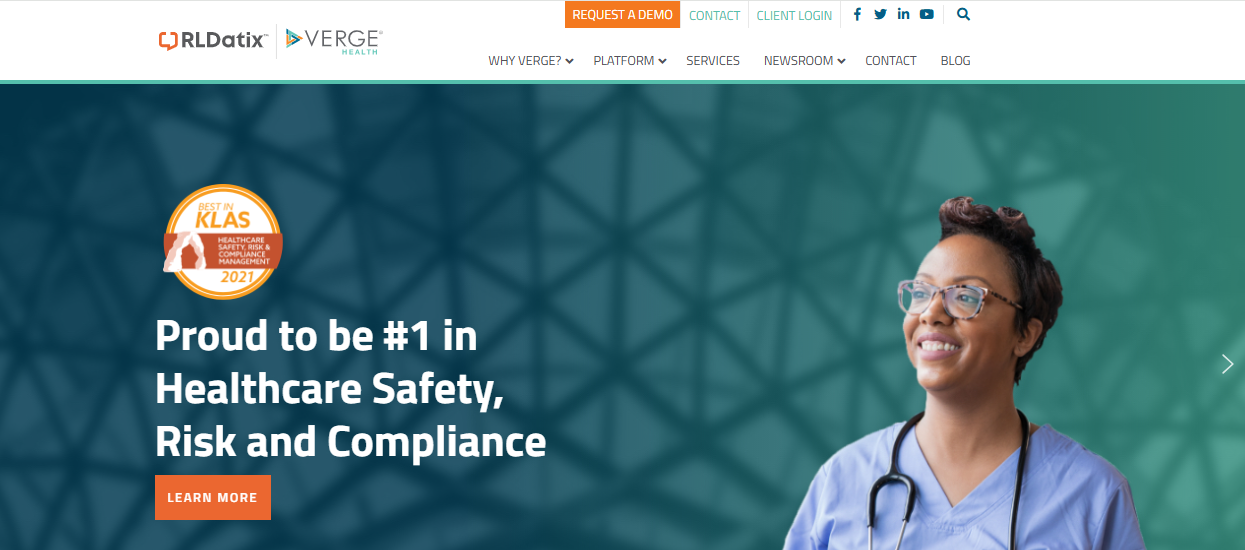

Verge Health, now a part of RLDatix, offers one of the most reliable governance, risk, and compliance (GRC) systems in the healthcare sector. Their software helps organizations transition from paper-based compliance management to a digital solution that transforms compliance data into actionable outcomes to improve patient and staff safety.
Key features of Verge Health include
- Complete guidelines
- Continuously updated
- Enterprise scalability
Compliance Focus
Verge Health’s robust compliance solution helps organizations achieve operational goals by optimizing safety and compliance to improve health outcomes.
5. HIPAA Secure Now: Automated HIPAA Compliance Management


HIPAA Secure Now! provides a comprehensive compliance software solution that helps organizations achieve and maintain HIPAA compliance. Their automated system takes the guesswork out of compliance and offers guidance from experienced compliance experts.
Key features of HIPAA Secure Now! include
- Automated HIPAA compliance management
- Employee training modules
- Network vulnerability scans
Compliance Focus
HIPAA Secure Now! simplifies managing HIPAA compliance to help organizations mitigate the risks of infiltrations that can lead to violations.
6. MedTrainer: Compliance and Credentialing for Healthcare Providers


MedTrainer offers a robust compliance management system focused on healthcare providers’ needs. Their comprehensive solution helps organizations achieve and maintain compliance and streamlines the credentialing process for new hires and external vendors.
Key features of MedTrainer include
- Compliance training and learning management
- Credentialing and provider enrollment
- Safety plan management
- Accreditation tracking
Compliance Focus
MedTrainer’s compliance software helps healthcare organizations manage compliance and credentialing simultaneously for a more streamlined approach.
7. Radar Healthcare: Real-Time Compliance Management
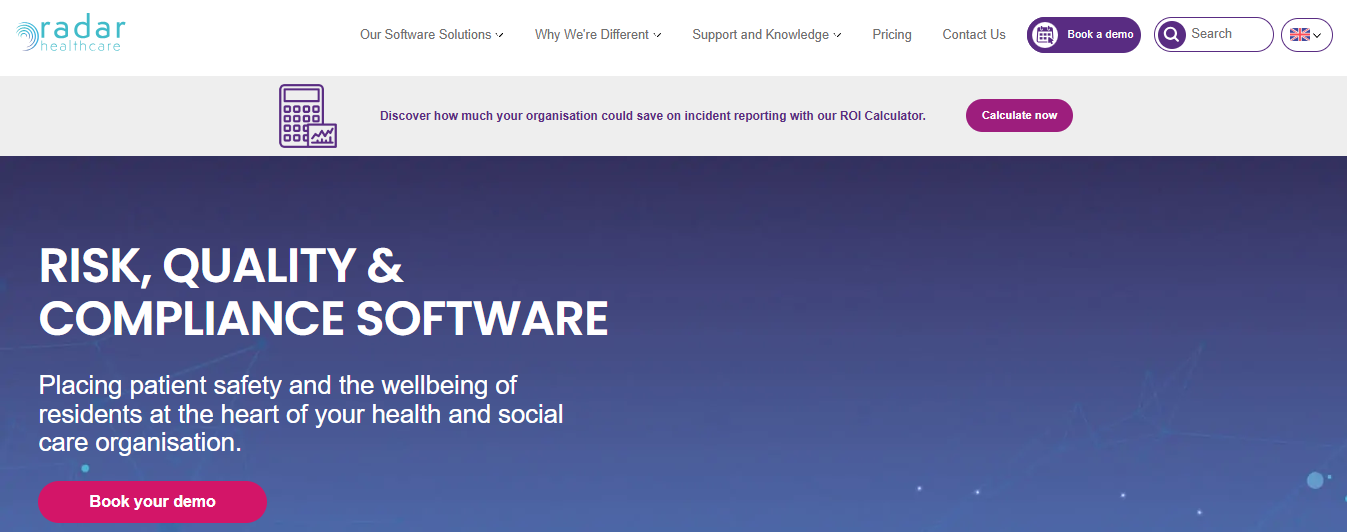

Radar Healthcare delivers a full-featured compliance management system that focuses on real-time data. Their advanced solution provides organizations with insight into their compliance status while automating crucial aspects of policy administration, reporting, and compliance monitoring.
Key features of Radar Healthcare include:
- Instant insights
- View data
- Delivering intelligence
Compliance Focus
Radar Healthcare’s software allows organizations to control compliance and reduce risks, creating a more effective and compliant healthcare environment.
8. ZenQMS: Quality Management and Compliance Software
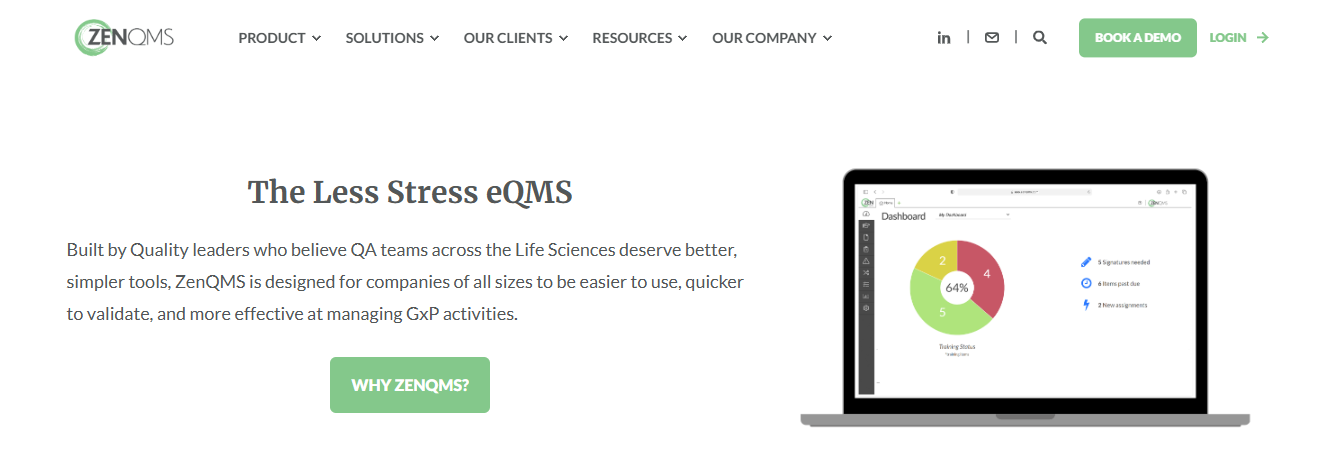

ZenQMS is cloud-based quality management software that can also serve as a compliance management solution for healthcare facilities. Its numerous modules ensure organizations’ adherence to regulations and improve the quality of care provided to clients.
Key features of ZenQMS include
- Secure document management
- Complete training visibility with analytics
- Audit management
Compliance Focus
ZenQMS helps organizations achieve compliance while enhancing overall operations for better patient care.
9. HIPAA Ready: Customizable Compliance Software
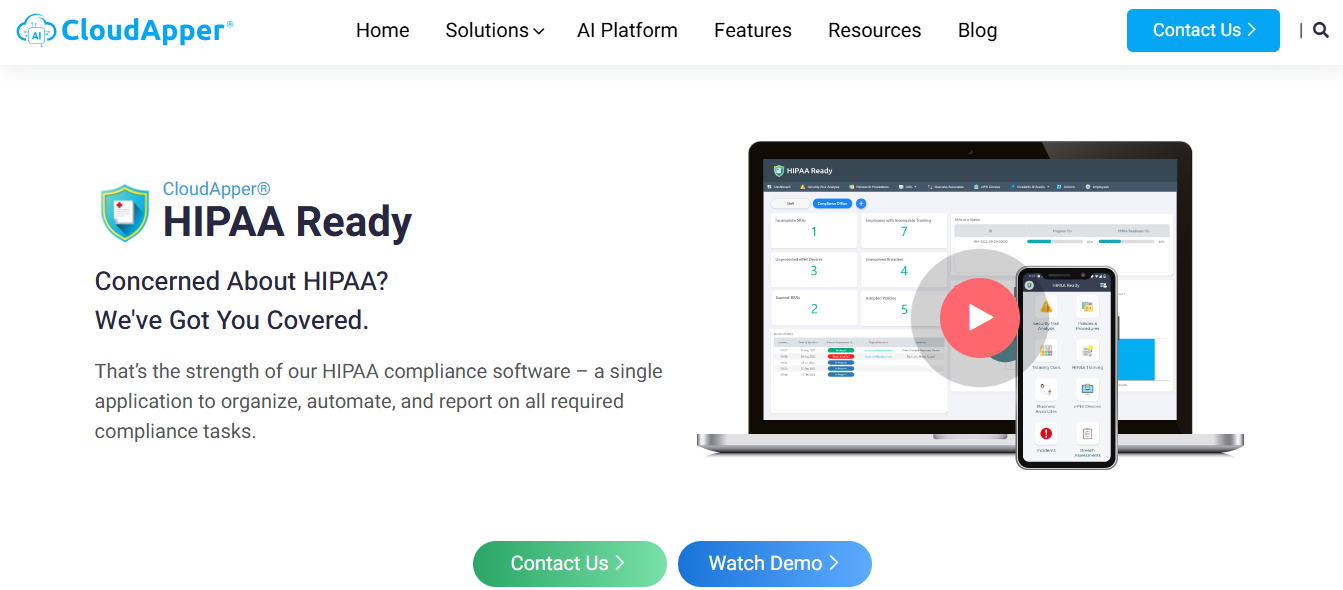

HIPAA Ready is compliance software that focuses on customization. Providers can customize it without coding knowledge to meet their practice’s specific requirements. Additionally, HIPAA Ready offers templates to expedite the process. The software developed by HIPAA Ready addresses policy and procedure formulation, compliance, training, and HIPAA certification.
Key features of HIPAA Ready include:
- Security risk analysis (SRA)
- Digital checklist
- Track progress
Compliance Focus
HIPAA Ready’s customizable solution helps organizations streamline HIPAA compliance to improve efficiency and preparedness for audits.
Related Reading
- Healthcare Provider Data Management
- MDM Implementation
- Reference Data Management
- Healthcare Data Integration
- Healthcare IT Consultants
11 Best Practices For Efficient Healthcare Data Compliance


1. Use Azulity: A Master Class in Healthcare Data Management
Azulity is a leader in healthcare master data management, specializing in data solutions and credentialing for organizations across the United States. Their robust platform facilitates the consistent synchronization of patient, provider, location, and claims data across all systems and departments. Key features include healthcare MDM, provider MDM, reference data management, credentialing, and provider enrollment. Azulity serves healthcare technology leaders – from CIOs and CDOs to VPs of data platforms and credentialing – helping them eliminate the costly problems of fragmented data systems. Book a call to learn more about their healthcare master data management services today!
2. Educate Healthcare Staff: Training Is Key
The human element remains one of the biggest threats to security across all industries, particularly in the healthcare field. Simple human error or negligence can result in disastrous and expensive consequences for healthcare organizations. Security awareness training equips healthcare employees with the knowledge to make intelligent decisions and use appropriate caution when handling patient data.
3. Restrict Access to Data and Applications: Limit Users to the Information They Need
Implementing access controls bolsters healthcare data protection by restricting access to patient information and specific applications to only those users who require access to perform their jobs. Access restrictions require user authentication, ensuring only authorized users can access protected data. Multi-factor authentication is a recommended approach, requiring users to validate that they are the person authorized to access specific data and applications using two or more validation methods, including:
- Information known only to the user, such as a password or PIN number
- Something that only the authorized user would possess, such as a card or key
- Something unique to the authorized user, such as biometrics (facial recognition, fingerprints, eye scanning)
4. Implement Data Usage Controls: Go Beyond Access Monitoring
Protective data controls go beyond the benefits of access controls and monitoring to ensure that risky or malicious data activity can be flagged and blocked in real-time. Healthcare organizations can use data controls to block specific actions involving sensitive data, such as web uploads, unauthorized email sends, copying to external drives, or printing. Data discovery and classification play a critical supporting role in this process by ensuring that sensitive data can be identified and tagged to receive the proper level of protection.
5. Log and Monitor Use: Keep Track of Data Access and Activity
Logging all access and usage data is also crucial. This enables providers and business associates to monitor which users access information, applications, and other resources, when, and from what devices and locations. These logs prove valuable for auditing purposes, helping organizations identify areas of concern and strengthen protective measures when necessary. When an incident occurs, an audit trail may enable organizations to pinpoint precise entry points, determine the cause, and evaluate damages.
6. Encrypt Data at Rest and in Transit: Scramble Data to Protect Patient Privacy
Encryption is one of the most valuable data protection methods for healthcare organizations. By encrypting data in transit and at rest, healthcare providers and business associates make it more difficult (ideally impossible) for attackers to decipher patient information even if they gain access to the data. HIPAA offers recommendations but doesn’t require healthcare organizations to implement data encryption measures; instead, the rule leaves it up to healthcare providers and business associates to determine what encryption methods and other measures are necessary or appropriate given the organization’s workflow and other needs.
Health IT Security outlines the two key questions that healthcare organizations should ask in determining an appropriate level of encryption and when encryption is needed, as recommended in the HHS HIPAA Security Series:
- What data should be encrypted and decrypted to prevent unauthorized access to ePHI (either by unauthorized persons or applications)?
- What methods of decryption and encryption are necessary, reasonable, and appropriate in preventing unauthorized persons and applications from gaining access to sensitive health information?
7. Secure Mobile Devices: Protect Portable Devices Containing Sensitive Data
Increasingly, healthcare providers and covered entities utilize mobile devices when doing business, whether a physician uses a smartphone to access information to help them treat a patient or an administrative worker processing insurance claims. Mobile device security alone entails a multitude of security measures, including:
- Managing all devices, settings, and configurations
- Enforcing the use of strong passwords
- Enabling the ability to wipe and lock lost or stolen devices remotely
- Encrypting application data
- Monitoring email accounts and attachments to prevent malware infections or unauthorized data exfiltration
- Educating users on mobile device security best practices
- Implementing guidelines or whitelisting policies to ensure that only applications meeting pre-defined criteria or having been pre-vetted can be installed
- Requiring users to keep their devices updated with the latest operating system and application updates
- Requiring the installation of mobile security software, such as mobile device management solutions
8. Mitigate Connected Device Risks: Secure the Internet of Things
When you think of mobile devices, you probably think of smartphones and tablets. However, the rise of the Internet of Things (IoT) means that connected devices take all forms. In healthcare, devices like blood pressure monitors or cameras used to monitor physical security on the premises may be connected to a network. To maintain adequate connected device security:
- Maintain IoT devices on their separate network.
- Continuously monitor IoT device networks to identify sudden changes in activity levels that may indicate a breach
- Disable non-essential services on devices before using them, or remove non-essential services entirely before use
- Use robust and multi-factor authentication whenever possible
- Keep all connected devices up-to-date to ensure that all available patches are implemented
9. Conduct Regular Risk Assessments: Evaluate Security Posture Over Time
While having an audit trail helps to identify the cause and other valuable details of an incident after it occurs, proactive prevention is equally important. Regular risk assessments can identify vulnerabilities or weak points in a healthcare organization’s security, shortcomings in employee education, inadequacies in the security posture of vendors and business associates, and other areas of concern. By evaluating risk across a healthcare organization periodically to proactively identify and mitigate potential risks, healthcare providers and their business associates can better avoid costly data breaches and the many other detrimental impacts of a data breach, from reputation damage to penalties from regulatory agencies.
10. Back up Data to a Secure, Offsite Location: Protect Against Ransomware and Other Disasters
Cyberattacks can expose sensitive patient information, but they can also compromise data integrity or availability – look no further than ransomware for an example of these incidents’ impact. Even a natural disaster impacting a healthcare organization’s data center can have disastrous consequences if data isn’t properly backed up. That’s why frequent offsite data backups are recommended, with strict controls for data encryption, access, and other best practices to ensure that data backups are secured. Offsite data backups are an essential component of disaster recovery, too.
11. Carefully Evaluate the Security and Compliance Posture of Business Associates: Don’t Leave a Door Open for Cybercriminals
Because healthcare information is increasingly transmitted between providers and among covered entities to facilitate payments and deliver care, carefully evaluating all potential business associates is one of the most crucial security measures healthcare organizations can take. The HIPAA Omnibus Rule strengthened the previous guidelines and clarified definitions of business associates, providing better guidance on the relationships in which contracts are required. The HIPAA Survival Guide summarizes these clarifications and changes, including:
- The conduit exception applies to organizations that transmit PHI but do not maintain and store it. Organizations that merely transmit data are not considered business associates, while those that maintain and store PHI are considered business associates.
- Third-party applications and services, such as Google Apps, are considered business associates when used to maintain PHI. In such cases, the third-party service would be viewed as a business associate; therefore, a contract would be required.
- The HIPAA Survival Guide aptly points out that as more organizations use the cloud, they should be mindful of all instances that would make a vendor a business associate and the likelihood of those vendors entering into the required contract.
- Any subcontractors who create or maintain PHI are subject to compliance regulations. This change alone has a substantial trickle-down effect and is a serious consideration for all healthcare organizations.
- All covered entities must obtain “satisfactory assurances” from all vendors, partners, subcontractors, and the like that PHI will be adequately protected. Liability follows PHI wherever it travels.
- There are some exceptions. As the HIPAA Survival Guide explains, “in general, a person or entity is a Business Associate only in cases where the person or entity is conducting a function or activity regulated by the HIPAA Rules on behalf of a Covered Entity, such as payment or healthcare operations; therefore a researcher is NOT automatically a Business Associate of a Covered Entity even though it may be using the Covered Entity’s Protected Health Information.”
Book a Call to Learn More About Our Healthcare Master Data Management Services
Azulity specializes in healthcare master data management, bringing proven expertise in implementing healthcare data solutions and credentialing across the US. Our comprehensive platform ensures consistent patient, provider, location, and claims data synchronization across all systems and departments.
Key features include healthcare MDM, provider MDM, reference data management, credentialing, and provider enrollment. We serve healthcare technology leaders – from CIOs and CDOs to VPs of data platforms and credentialing – helping them eliminate the costly problems of fragmented data systems. Book a call to learn more about our healthcare master data management services today!